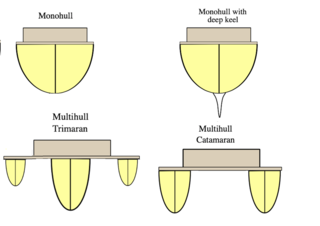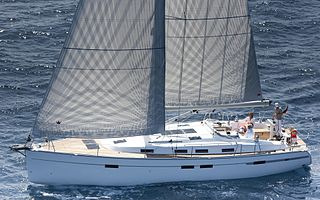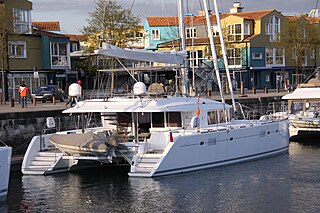
A multihull is a boat or ship with more than one hull, whereas a vessel with a single hull is a monohull. The most common multihulls are catamarans, and trimarans. There are other types, with four or more hulls, but such examples are very rare and tend to be specialised for particular functions.

A yacht is a sail- or motor-propelled watercraft made for pleasure, cruising, or racing. There is no standard definition, though the term generally applies to vessels with a cabin intended for overnight use. To be termed a yacht, as opposed to a boat, such a pleasure vessel is likely to be at least 33 feet (10 m) in length and may have been judged to have good aesthetic qualities.

A catamaran is a watercraft with two parallel hulls of equal size. The wide distance between a catamaran's hulls imparts stability through resistance to rolling and overturning; no ballast is required. Catamarans typically have less hull volume, smaller displacement, and shallower draft (draught) than monohulls of comparable length. The two hulls combined also often have a smaller hydrodynamic resistance than comparable monohulls, requiring less propulsive power from either sails or motors. The catamaran's wider stance on the water can reduce both heeling and wave-induced motion, as compared with a monohull, and can give reduced wakes.
Strip-built, or "strip-plank epoxy", is a method of boat building. Also known as cold molding, the strip-built method is commonly used for canoes and kayaks, but also suitable for larger boats. The process involves securing narrow, flexible strips of wood edge-to-edge around temporary formers. The temporary formers are usually created via a process called "lofting" whereby a set of tables is used to generate the shapes of the formers. The strips are glued edge-to-edge with epoxy. It is effectively a modern form of carvel which needs no caulking and which is both stiffer and more watertight. In a small boat, there will be just one layer of strip-planking, but larger vessels may have two or three layers which,, forms a light, strong, and torsionally stiff monococque.

Hobie Cat is a company that manufactures watercraft and other products as the Hobie Cat Company. "Hobie Cat" can also refer to specific products of the company, notably its sailing catamarans. Its fiberglass catamaran models range in nominal length between 14 feet (4.3 m) and 18 feet (5.5 m). Rotomolded catamaran models range in length between 12 feet (3.7 m) and 17 feet (5.2 m). Other sailing vessels in the Hobie Cat lineup include, monocats, dinghies, and trimarans, ranging in length between 9 feet (2.7 m) and 20 feet (6.1 m). Its largest product was the Hobie 33, 33 feet (10 m) in length. The company's non-sailing product line includes surfboards, kayaks, stand-up paddle boards, pedalboards, eyeware, and e-bikes. It was founded in 1961 by Hobart (Hobie) Alter, who originally manufactured surfboards.
Element Yachts is a second generation Canadian boatbuilding company located in Erin, Ontario. The company is currently producing the Element line of express cruiser boats with the first model of the series, the 27-foot (8.2 m) Element 270 EXC beginning production in 2005. Element Yachts focuses primarily on the powerboat sector of the boating market, and sells its products worldwide.

The Topcat is a one-design sailing catamaran boat class which is divided into several boat sizes.

The Nacra F18 Infusion was announced in 2006 and launched in January 2007 as a one design racing catamaran conforming to the Formula 18 class rules. It quickly developed into a class in its own right.
Douce France is a 138 feet luxury sailing catamaran design by VPLP design and built by Alumarine in Brittany (France). At its launch in 1998, she was the largest sailing cat ever built and won most innovative Sailing Yacht 1999 - Showboats Design Awards. It was built at Alu Marine also underwent a refit in 2009 and 2015. The exterior and interior design was done overall by Peteghem & Lauriot Prevost. The vessel is known for a panoramic window interior lounge, one of the areas along with the teak wood aft deck, upper level cockpit, and the interior cabins in the twin hulls.
Catalac is a defunct English maritime construction company that specialised in building sailing catamarans. The company was founded by Tom Lack, in Christchurch, Dorset. After a successful period of production, the company closed in 1986. In the 1990s, the Catalac 9M was briefly revived and updated in the US as the "Catalac 900".
The Gougeon 32 is an American trailerable catamaran that was designed by Jan Gougeon and first built in 1990.

The Nacra 20 is a catamaran sailing dinghy that was designed by Gino Morrelli and Pete Melvin as a one-design racer and first built in 1998.

The Albin 82 MS is a Swedish sailboat design that was designed by Per Brohäll as motorsailer and first built in 1975.
The Eastward Ho 24 is an American trailerable sailboat that was designed by Walter McInnis of Eldridge-McInnis, as a cruiser and first built in 1975.
The Lagoon 37 is a French catamaran sailboat that was designed by Van Peteghem/Lauriot-Prevost as a cruiser and first built in 1991.
The Lagoon 570 is a French sailboat that was designed by Van Peteghem/Lauriot-Prevost as a cruiser and first built in 2000.
The Lagoon 420 is a French sailboat that was designed by Van Peteghem/Lauriot-Prevost as a cruiser and yacht charter boat, first built in 2006, as a 2007 model year introduction.
The Lagoon 52 is a French sailboat that was designed by Van Peteghem/Lauriot-Prevost, with the exterior design by Patrick le Quément and interior by the Italian firm Nauta Design. It was intended as a cruiser and for the yacht charter role and first built in 2011.

The Lagoon 560 is a French sailboat that was designed by Van Peteghem/Lauriot-Prevost, with the exterior design by Patrick le Quément and interior design by Nauta Design. It was intended as an offshore cruiser and also for the yacht charter role and first built in 2010.









